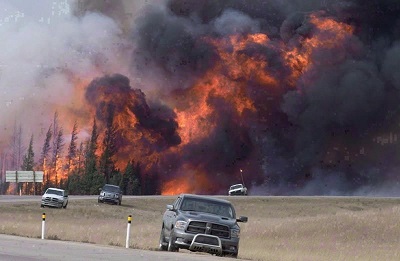 Friday, July 26, 2024
Friday, July 26, 2024  Friday, July 26, 2024
Friday, July 26, 2024 
Got news? Next submission deadline is Friday at 5:00 p.m.
Click here to submit YOUR news

It was May 8, 2016, and the Fort McMurray wildfire was in full blaze.
Municipal and provincial leaders had gathered to discuss a response when Chief Allan Adam of the Athabasca Chipewyan First Nation walked in wanting to know how their plans would affect Indigenous communities.
“All these heads started looking at each other and they had no answers for me,” he recalls. “It was clearly evident they had no plans for emergency procedures for First Nations in the surrounding area.”
That’s also the main conclusion of a lengthy report by 11 Indigenous communities in and around Fort McMurray. It was funded by the Red Cross and is the result of two years of surveys, meetings and focus groups.
“You had this breakdown in understanding,” said Tim Clark, the consultant who wrote the report.
The Fort McMurray wildfire became one of Canada’s worst natural disasters.
More than 88,000 residents fled their homes and more than 2,400 structures were damaged or destroyed. The estimated cost was pegged at about $10 billion and nearly 6,000 square kilometres in northern Alberta were scorched.
There were no deaths directly caused by the fire, but the report suggests that wasn’t because things went smoothly.
Nobody knew who was in charge, it says. Between municipalities, the province and Ottawa, responsibility for Indigenous communities was up in the air.
There were few relationships and less trust between government and First Nations groups, says the report. Indigenous leaders weren’t included in the Regional Emergency Operations Centre.
“You had Fort McMurray First Nation, just east of Fort McMurray, and they didn’t even know there was an emergency operations centre,” Clark said. “(The municipality) did not reach out to First Nations because it assumed they were being dealt with by the federal government.”
Most residents from the nearby hamlet of Janvier left for safety in Lac La Biche, 175 kilometres away. But when a few Janvier kids acted up, everyone, including elders, was rousted and moved again — some back to Janvier, which was still under threat.
Re-entry after the fire was similarly tone-deaf, the report says.
Watch our video and learn more about the benefits of joining Construction Links Network – the peer-to-peer network sharing platform for the construction, building and design community.
Press Releases | Project Updates | New Appointments | Awards & Milestones | Company News | New Products/Services | Brochures | Videos | Infographics | Blog Sharing | Events and More